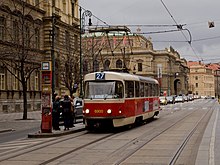**Historical Development of Trams**:
– Passenger trams originated in the early 19th century.
– Predecessors included wooden wagonways and Roman limestone trackways.
– Horse-drawn trams began with the Swansea and Mumbles Railway in Wales in 1807.
– The first permanent tram line in continental Europe was opened in Paris in 1855.
– Tram history can be divided into distinct periods based on power sources.
– Paved plateways with cast iron rails were introduced in England in the 1700s.
– Street railways developed in America before Europe due to poor street conditions.
**Advantages and Resurgence of Trams**:
– Trams had low rolling resistance due to metal wheels on steel rails.
– Trams replaced animal power in the late 19th and early 20th centuries.
– Trams could carry heavier loads more efficiently than earlier transit.
– Improvements in vehicles like buses led to a decline in trams in the mid-20th century.
– Trams have seen a resurgence in recent years as a mode of public transport.
**Infrastructure and Global Impact**:
– Trams run on urban rail transit tracks in public streets.
– Tram vehicles are lighter and shorter than mainline trains.
– Most trams use electrical power fed by overhead lines.
– Trams may have dual power systems for urban and rural environments.
– Some trams, known as tram-trains, run on mainline railway tracks.
– The Melbourne tram network is the world’s largest with 250km of track.
– Trams provided a smoother ride compared to horsebuses on poorly paved streets.
**Evolution of Tram Power Sources**:
– Steam trams were the first mechanical trams powered by steam.
– Cable-hauled trams operated on a system pulled by a moving steel cable on a fixed track.
– Gas trams were powered by gas, naphtha gas, or coal gas in the late 19th and early 20th centuries.
– Electric trams became popular in the late 19th and early 20th centuries.
– Battery-powered trams have been explored in history and are being adopted in modern cities.
– Compressed air trams and human-powered trams were also historical power sources.
**Innovations and Future Trends in Tram Technology**:
– Modern tram systems focus on sustainability, efficiency, and integration with urban planning.
– Advancements in tram technology include low-floor designs, energy-efficient systems, and wireless charging.
– Integration of trams with other modes of public transportation for seamless urban mobility.
– Expansion of tram networks in growing cities to reduce congestion and emissions.
– Collaborations between governments, private sectors, and urban planners to enhance tram infrastructure and services.
A tram (called a streetcar or trolley in the United States) is a type of urban rail transit consisting of a rail vehicle, either individual railcars or self-propelled trains coupled by a multiple unit, that runs on tramway tracks on urban public streets; some include segments on segregated right-of-way. The tramlines or networks operated as public transport are called tramways or simply trams/streetcars. Many recently built tramways use the contemporary term light rail.


Tram vehicles are usually lighter and shorter than main line and rapid transit trains. Today, most trams use electrical power, usually fed by a pantograph sliding on an overhead line; older systems may use a trolley pole or a bow collector. In some cases, a contact shoe on a third rail is used. If necessary, they may have dual power systems—electricity in city streets and diesel in more rural environments. Occasionally, trams also carry freight. Trams are now commonly included in the wider term "light rail", which also includes grade-separated systems. Some trams, known as tram-trains, may have segments that run on mainline railway tracks, similar to interurban systems. The differences between these modes of rail transport are often indistinct and a given system may combine multiple features.

One of the advantages over earlier forms of transit was the low rolling resistance of metal wheels on steel rails, allowing the trams to haul a greater load for a given effort. Another factor which contributed to the rise of trams was the high total cost of ownership of horses. Electric trams largely replaced animal power in the late 19th and early 20th centuries. Improvements in other vehicles such as buses led to decline of trams in the mid 20th century. However, trams have seen resurgence in recent years.
